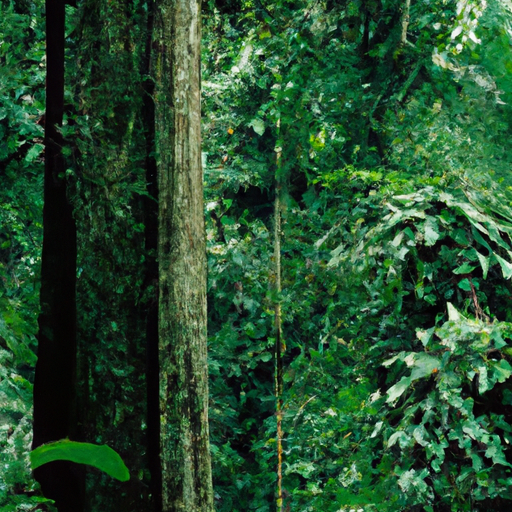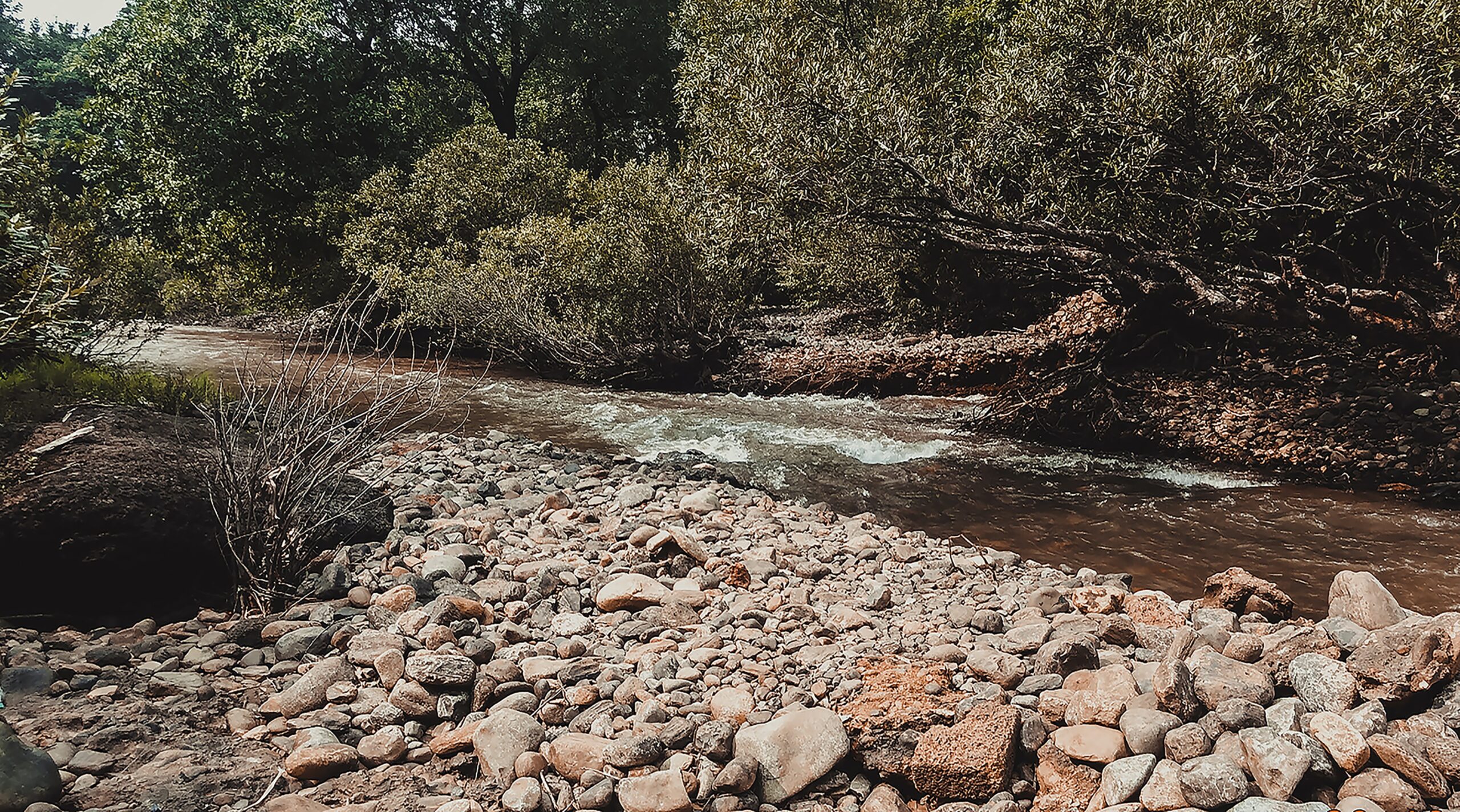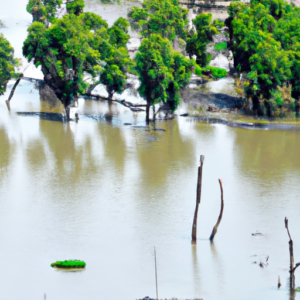Why Are Rainforests Often Referred To As The Lungs Of Our Planet: Introduction
Why are rainforests often referred to as the lungs of our planet? Imagine a world without clean air. A world where taking a deep breath becomes an ordeal, and oxygen becomes an elusive luxury. Thankfully, we don’t have to worry about that because we have our rainforests. These lush green wonders are often referred to as the lungs of our planet, tirelessly working to provide us with the fresh air we need to survive.
But have you ever wondered why? Join us as we explore the incredible role that rainforests play in our planet’s respiratory system. Get ready to discover a whole new appreciation for these breathtaking ecosystems and answer the question, “Why are rainforests often referred to as the lungs of our planet?”
The Oxygen Factory: Rainforests, found predominantly near the equator, are the true powerhouses of oxygen production. Through a remarkable process called photosynthesis, the myriad of plants and trees in these ecosystems convert carbon dioxide into oxygen. This relentless oxygen factory doesn’t just contribute a significant portion of the world’s breathable air; it plays a fundamental role in the delicate balance of our planet’s atmospheric composition.
Carbon Dioxide Absorption: While they churn out oxygen, rainforests also act as nature’s carbon dioxide absorbers. They absorb and store vast quantities of carbon dioxide from the atmosphere, playing a vital role in combating the greenhouse effect and mitigating climate change. In essence, they function as the Earth’s natural air purifiers, regulating the levels of this potent greenhouse gas.
Climate Control: But the influence of rainforests goes beyond just producing oxygen and absorbing carbon dioxide. They have a profound impact on climate regulation. The moisture released through a process called transpiration affects weather patterns and rainfall distribution both locally and globally. By maintaining stable weather systems, rainforests indirectly ensure that agriculture thrives, making them crucial for food security.
Biodiversity Hotspots: Rainforests are not just the lungs but also the heart of our planet’s biodiversity. These rich ecosystems host an astonishing diversity of plant and animal species, many of which are found nowhere else on Earth. The interconnected web of life in rainforests is vital for genetic diversity and ecosystem stability, making them a treasure trove of biological wonder.
Conservation Imperative: However, the future of these invaluable ecosystems is under threat from deforestation, logging, and habitat destruction. As we delve deeper into understanding why rainforests are the lungs of our planet, it becomes clear that their conservation is not just a matter of ecological concern but a moral and global imperative.
In our exploration of this intricate relationship between rainforests and the health of our planet, we will uncover the vital role these ecosystems play in sustaining life on Earth. Join us on this journey to appreciate and advocate for the preservation of these natural wonders, for they are not just the lungs but the very lifeblood of our world.
Check Out Our Top Eco Friendly Product Picks On Amazon Here
What are rainforests?
Definition of rainforests
Rainforests are lush, vibrant, and diverse ecosystems that are characterized by their dense vegetation and abundant rainfall. They are predominantly found in tropical regions near the equator, such as the Amazon, Congo, and Southeast Asia. Rainforests are teeming with life, hosting an array of plant and animal species that are uniquely adapted to thrive in their specific habitats.
Characteristics of rainforests
Rainforests are known for their extraordinary biodiversity, containing a staggering variety of plants, animals, and microorganisms. They possess a dense canopy of tall trees, creating a virtual “roof” that filters sunlight and creates a shaded, humid environment below. This canopy holds as much as 90% of the rainforest’s plant species. The forest floor is carpeted with decomposing organic matter, providing vital nutrients for the growth of new plants. Additionally, rainforests receive a significant amount of rainfall throughout the year, contributing to their incredible fertility.
Locations of rainforests
While rainforests are found around the world, the majority of them are concentrated in three main regions: the Amazon Basin in South America, the Congo Basin in Central Africa, and the rainforests of Southeast Asia. However, rainforests can also be found in regions such as Central America, the Caribbean, and the Pacific Islands.
Why are rainforests important?
Biodiversity hotspots
Rainforests are considered biodiversity hotspots due to their astounding range of species. They are home to more than half of the world’s plant and animal species, many of which are found nowhere else on Earth. Rainforests provide essential habitats for endangered and rare species, acting as a crucial reservoir for genetic diversity.
Carbon storage
Rainforests play a vital role in carbon storage, acting as the Earth’s largest “carbon sinks.” Trees absorb carbon dioxide (CO2), a major greenhouse gas responsible for climate change, during the process of photosynthesis. By removing CO2 from the atmosphere, rainforests play a crucial role in mitigating climate change by reducing its concentration.
Climate regulation
Rainforests help regulate the Earth’s climate by participating in the water cycle. They release vast amounts of moisture into the atmosphere through a process known as transpiration. This moisture forms clouds, which contribute to rainfall patterns not only locally but also on a global scale. Rainforests also act as a buffer against extreme weather events such as droughts, floods, and hurricanes.
Oxygen production
Rainforests are often referred to as the “lungs of the planet” because they produce a significant amount of the Earth’s oxygen. Through the process of photosynthesis, plants in the rainforest convert carbon dioxide into oxygen. This oxygen is released into the atmosphere, providing the essential air we breathe.
Medicinal resources
Rainforests are a vast storehouse of medicinal resources, with a wealth of plant species possessing unique chemical properties. Indigenous communities have long relied on these forests for the treatment of various ailments. Many modern medicines, such as treatments for cancer, malaria, and other diseases, have been derived from plants and organisms found in rainforests. Ongoing research in rainforest biodiversity holds tremendous potential for discovering new medical breakthroughs.
Check Out Our Top Eco Friendly Product Picks On Amazon Here
The analogy between rainforests and lungs
Understanding the lung metaphor
The analogy between rainforests and lungs represents the interconnectedness of these vital systems within the Earth’s ecosystem. Just as lungs exchange oxygen and carbon dioxide to sustain human life, rainforests perform a similar function on a global scale by regulating the atmospheric composition.
Similarities between rainforests and lungs
Rainforests and lungs share several similarities. Both systems are incredibly efficient at the exchange of gases. Lungs intake oxygen while expelling carbon dioxide, and rainforests absorb carbon dioxide while releasing oxygen. Furthermore, the delicate balance and functionality of both systems are paramount to the overall health and well-being of their respective ecosystems.
Differences between rainforests and lungs
While the analogy between rainforests and lungs helps us grasp the overall concept of their interconnectedness, it is essential to note the fundamental differences between the two systems. Rainforests possess a much greater capacity for carbon dioxide absorption and oxygen production compared to human lungs. Additionally, rainforests are incredibly complex ecosystems hosting a diverse range of wildlife, while lungs serve as an organ within a singular organism.
Carbon dioxide absorption
The role of rainforests in the carbon cycle
Rainforests play a crucial role in the carbon cycle by absorbing and storing vast amounts of carbon dioxide. Through the process of photosynthesis, trees capture atmospheric carbon dioxide and convert it into organic matter. This process locks the carbon within the tree’s structures, effectively removing carbon dioxide from the atmosphere.
Processes of CO2 absorption
The absorption of carbon dioxide in rainforests occurs primarily through the process of photosynthesis. Trees and other plants take in carbon dioxide along with sunlight and water, converting it into glucose and releasing oxygen as a byproduct. This glucose is further utilized for energy and growth within the plant, effectively sequestering carbon within its biomass.
The significance of CO2 absorption
By absorbing carbon dioxide, rainforests help to mitigate the excessive buildup of greenhouse gases in the atmosphere, thus combatting climate change. The capacity of rainforests to sequester carbon is critical for stabilizing global carbon levels and maintaining a balanced and healthy climate.

Oxygen production
The process of oxygen production in rainforests
Rainforests are vital in the production of oxygen through the process of photosynthesis. During photosynthesis, plants utilize sunlight, water, and carbon dioxide to produce glucose and release oxygen as a byproduct. This oxygen is then released into the atmosphere, providing the air necessary for the survival of countless organisms.
Photosynthesis and its importance
Photosynthesis is one of the most fundamental processes on Earth, essentially driving much of life’s existence. Through this process, plants harness solar energy, transforming it into chemical energy stored in glucose molecules. This energy source fuels not only the plant but also entire ecosystems, making photosynthesis a fundamental pillar of the natural world.
Oxygen output from rainforests
It is estimated that rainforests produce approximately 20% of the world’s oxygen. Though this may not be the entirety of the Earth’s oxygen supply, the contribution of rainforests is significant. Sustaining the health and abundance of rainforests is crucial for maintaining oxygen levels necessary for the survival of all living organisms.
Role in regulating climate
Rainforests and the water cycle
Rainforests play a vital role in regulating the Earth’s climate by participating in the water cycle. The dense vegetation within rainforests supports a high rate of evapotranspiration, where water is released through the leaves of plants into the atmosphere. This process contributes to the formation of clouds and subsequent rainfall, redistributing moisture across the planet.
Influence on rainfall patterns
Rainforests help create and maintain rainfall patterns, not only in their immediate vicinity but also in other parts of the world. The moisture released by rainforests significantly impacts local and global weather systems, ensuring the distribution of rainfall to areas that rely on it for agriculture, freshwater reserves, and overall ecological balance.
Effects of deforestation on climate
Deforestation, the clearance of forests for various purposes, has detrimental effects on the Earth’s climate. As rainforests are cleared, the capacity to regulate rainfall and temperatures is compromised, leading to changes in local weather patterns. Additionally, deforestation releases significant amounts of stored carbon dioxide into the atmosphere, exacerbating climate change and further disrupting the delicate balance of the Earth’s climate system.

Biodiversity and ecosystems
Richness of species in rainforests
Rainforests are unparalleled in their biodiversity, supporting a vast array of plant and animal species. Estimates suggest that rainforests may contain up to half of the world’s species, despite covering less than 2% of the Earth’s surface. These ecosystems provide habitats for countless unique and specialized organisms, contributing to the overall web of life on our planet.
Interconnectedness of ecosystems
Rainforests are incredibly interconnected, with each organism playing a crucial role in maintaining the health and functioning of the overall ecosystem. From the plants at the forest floor, to the creatures dwelling in the treetops, every species contributes to the delicate balance of the rainforest ecosystem. Disruptions or loss of any one species can have cascading effects on the entire ecosystem.
The impact of deforestation on ecosystems
The ongoing threat of deforestation poses numerous risks to rainforest ecosystems. When forests are cleared, habitats are destroyed, forcing many species into decline or pushing them towards extinction. The loss of species has a domino effect, impacting the functioning of the overall ecosystem. Additionally, the disruption of ecosystems in rainforests can have significant consequences for indigenous communities who rely on these forests for their livelihood and cultural heritage.
Medicinal resources found in rainforests
Rainforests as a pharmacy
Rainforests harbor an abundance of medicinal resources, making them akin to a “pharmacy” of the natural world. Indigenous communities residing in these areas have long relied on rainforest plants for their medicinal properties, passing down knowledge from generation to generation. Many pharmaceutical discoveries have been made through the exploration of rainforest biodiversity, with numerous plants providing compounds that can be synthesized into life-saving drugs.
Traditional medicine and indigenous knowledge
Indigenous communities possess a wealth of knowledge regarding the medicinal properties of rainforest flora. Their traditional medicine practices often involve the use of plants and their extracts for the treatment of various ailments. The preservation of rainforest ecosystems is essential not only for protecting these invaluable resources but also for respecting and honoring indigenous knowledge and cultural practices.
Potential for future medical discoveries
Rainforests hold immense potential for future medical discoveries. With only a fraction of the Earth’s species studied for their medicinal properties, it is likely that many more valuable compounds and potential cures remain undiscovered. The continued protection and conservation of rainforests are crucial in ensuring that these resources are available for future generations to unlock and benefit from.

Threats to rainforests
Deforestation
Deforestation remains one of the most significant threats to rainforests worldwide. The clearing of land for agriculture, logging, infrastructure development, and other purposes leads to the irreversible loss of forested areas. Deforestation not only destroys critical habitats but also contributes to climate change through the release of stored carbon dioxide.
Illegal logging
Illegal logging poses a severe threat to rainforest ecosystems, perpetuating the cycle of deforestation and undermining sustainable practices. This illicit activity not only fuels the demand for timber but also disrupts conservation efforts and undermines the livelihoods of local communities dependent on the forests for their well-being.
Agricultural expansion
The expansion of agriculture, particularly for commodity crops such as palm oil, soybeans, and cattle ranching, has resulted in vast areas of rainforest being cleared. As global demand for these products continues to rise, rainforests are increasingly threatened by the conversion of land for agricultural purposes. This expansion not only accelerates deforestation but also diminishes the resilience of ecosystems and disrupts vital ecological processes.
Climate change
Climate change poses a direct threat to rainforest ecosystems, altering rainfall patterns, and increasing the frequency and intensity of extreme weather events. Rising temperatures and shifting climate zones can have detrimental effects on the delicate balance of rainforest ecosystems, impacting the survival and distribution of plant and animal species.
Mining
Mining activities, such as extraction of minerals and fossil fuels, have a devastating impact on rainforest ecosystems. It involves the clearing of land, contaminating water sources, and disrupting habitats. The pollution and destruction caused by mining jeopardize the delicate equilibrium of these ecosystems and further exacerbate the loss of biodiversity.
Conservation efforts for rainforests
Protected areas and national parks
Protected areas and national parks are crucial in preserving rainforest ecosystems. These designated areas provide legal protection and management to ensure the long-term survival of critical habitats and the species that rely on them. These conservation efforts are essential for maintaining the integrity of rainforest ecosystems and safeguarding their biodiversity.
International agreements and regulations
International agreements and regulations play a significant role in promoting rainforest conservation. Initiatives such as the United Nations Framework Convention on Climate Change (UNFCCC) and the Convention on Biological Diversity (CBD) aim to address the challenges of climate change and biodiversity loss, respectively. These global frameworks foster cooperation among nations and encourage sustainable practices to protect and conserve rainforests.
Sustainable practices
Adopting sustainable practices is essential for safeguarding rainforests. This includes responsible logging, promoting agroforestry, and supporting initiatives that prioritize conservation and restoration. Sustainable practices aim to find a balance between human development and environmental preservation, ensuring the long-term viability of rainforest ecosystems.
Importance of public awareness
Raising public awareness about the value and vulnerability of rainforests is crucial for their conservation. Education and outreach programs play a vital role in informing individuals about the diverse benefits rainforests provide and the urgent need for their protection. By fostering a sense of stewardship and understanding among communities, we can collectively work towards ensuring the long-term survival of these irreplaceable ecosystems.
In conclusion, rainforests are invaluable ecological treasures that serve as the lungs of our planet. They play a vital role in biodiversity, carbon storage, climate regulation, oxygen production, and medicinal resources. Rainforests face numerous threats, including deforestation, illegal logging, agricultural expansion, climate change, and mining. However, through conservation efforts, protected areas, sustainable practices, and global cooperation, we can strive to protect and preserve these remarkable ecosystems for future generations. It is essential that we recognize the importance of rainforests and take action to ensure their continued survival.
Why Are Rainforests Often Referred To As The Lungs Of Our Planet: In A Nutshell
In conclusion, rainforests are often referred to as the “lungs of our planet” for good reason. These remarkable ecosystems play a vital role in sustaining life on Earth, from the rich biodiversity they house to their profound impact on the global climate.
Life-Sustaining Biodiversity: Rainforests are teeming with life, hosting an astonishing array of plant and animal species, many of which are yet to be discovered and studied. Their incredible biodiversity is not only a source of wonder but also a critical component of the planet’s ecological balance. These rainforests provide habitats for countless species, many of which are found nowhere else on Earth.
Oxygen Production: One of the primary reasons rainforests are dubbed the “lungs” of our planet is their role in oxygen production. Through the process of photosynthesis, trees and plants in these lush environments absorb carbon dioxide and release life-sustaining oxygen. This oxygen production is a cornerstone of Earth’s atmosphere, making it possible for humans and countless other creatures to breathe.
Carbon Sequestration: In addition to producing oxygen, rainforests are also powerful carbon sinks. They absorb and store vast amounts of carbon dioxide, helping to regulate the Earth’s climate by mitigating the greenhouse effect. As the world grapples with the challenges of climate change, the preservation of rainforests becomes paramount in the fight against rising global temperatures.
Climate Regulation: Rainforests play a pivotal role in regulating regional and global climates. They release moisture into the atmosphere through a process called transpiration, which in turn influences weather patterns and rainfall distribution. This not only sustains the ecosystems within the rainforests but also has far-reaching effects on agriculture and weather systems around the world.
Human Connection: It’s crucial to recognize that the significance of rainforests extends beyond their environmental contributions. Indigenous communities have inhabited these regions for generations, relying on their resources and traditional knowledge for survival. Protecting rainforests is not only an ecological imperative but also an ethical one, as it involves respecting the rights and cultures of these indigenous peoples.
In conclusion, the designation of rainforests as the “lungs of our planet” is a testament to their multifaceted importance. These vibrant ecosystems are essential for sustaining life, regulating the climate, and preserving biodiversity. It is incumbent upon us to recognize their value, protect them from deforestation and other threats, and work collectively to ensure their continued existence for generations to come. The health of our planet and the well-being of all its inhabitants are intricately linked to the preservation of these precious natural wonders.




